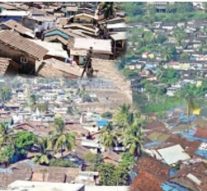Goa is abuzz with excitement as vintage bike and car owners, users, collectors and fans are decking […]

GOA IS TURNING INTO A SLUM!
Aug 23- Aug 29, 2025, In the News August 22, 2025BY Rajan Narayan
MORE than one-third of the population of Goa now lives in the large number of slum colonies that have come up all over Goa. The first slum colony to come up in Goa were perhaps the Zuarinagar slum which continues to be referred to as “Fukatnagar.” Fukatnakar provided housing for the large number of migrant labor who came from the neighboring states to work at the Mormugao Port Trust in port city Vasco da Gama.
Subsequently, slum colonies came up all around the Verna Industrial Estate including small villages like Nuvem, much to the disgust of the Goan villagers. The Baina red light district came up to meet the physical needs of the migrants who had come alone and did not bring their families with them. Subsequently, new slum colonies came up around all the urban areas in Goa, both in north and south Goa.
The commercial capital of Goa, Margao, saw large slum settlements of Muslim migrants in Moti Dongor. The 2011 census reminds that there are 26,000 plus people living in slum conditions across the three municipality areas of Mormugoa, Ponda and Margao. The most shocking taluka is Mormugoa where almost 40% of the residents live in slum conditions. Of the almost two lakh residents of the Mormugoa taluka between 40 to 50 thousand live in the ten slum areas including Baina, Dongor Hill, Khariwada Jetty, Gandhinagar, New Waddo and Shantinagar.
There is severe overcrowding in Shantinagar where over a 1,000 people are crammed in just 35 households, giving an average of 22 residents per household. Besides Moti Dongor, Margao has another large slum settlement, which is ironically called Azad Nagar. The residents have not got freedom from squalid living conditions, in many cases there is no running water and sewage system in place.
STARK SITUATIONS
THE situation is very stark in Moti Dongor where over 2,000 residents living in 402 houses now have no toilets, and rely on other sanitation arrangements. There are just 12 water points and only 0.5km of paved roads. Electricity connections have however been provided thanks to the intervention of local MLA Digambar Kamat. In the new Wadde area in Mormugoa 1,100 houses share 180 public toilets and have access only to three public water tanks.
IN north Goa also there are a large number of slums. This slums have come up in the market place down Mapusa and in Chimbel and Merces. There are also several slum colonies in the capital city Panaji. Wherever there is a lot of commercial activity and employment opportunities or unskilled and semi-skilled migrant labor, inevitably slums come up.
Unlike in other parts of country like Mumbai which have huge slums with lakhs of people staying in it, Goan slums are relatively small. What is disturbing however is that even in coastal tourist belts several illegal shanty colonies have come up in Calangute, Candolim, Arambol, Colva, Benaulim, Betalbatim in south Goa. Moreover, as in the case of Verna, big slum colonies have come up around other industrial estates in Cuncolim and elsewhere.
20% IN SLUMS
ACCORDING to the present population estimates almost 20% of the population of Goa lives in slums. What distinguishes a slum from village houses or housing colonies is the construction material used. Most of the houses in the slum are made of mud and other cheap material like tin roofs; none of the slums have basic facilities like toilets or drinking water provision. Though all of them seem to have electricity connection legal or illegal.
A distinction has to be made between legal and illegal slums. Very few of the over three dozen or more slums in Goa have been officially notified. In Mormugoa only Baina and Mongor Hill have official recognition. The new Vaddem slum which is the largest slum in Mormugoa taluka with over 5,000 residents remains un-notified.
Similarly, the slums in Ponda taluka have yet to be officially recognized by the State government. In north Goa as far as we know only Chimbel is officially recognized. When a slum is officially notified the State government has an obligation to provide basic infrastructure. It is not only the migrant population which lives in slums. Shockingly, even tribal Goan residents live in the very large Aivo slum which is just below the Raj Bhavan hillock.
The Goa government does not seem to be interested in providing basic amenities to slums or finance any re-development. Apparently, the budget allotted over the last three years for slum development, has been on an average of only five years. There is no budgetry provision for development of slums in the financial year 2025-2026.
MLA VOTE BANKS
AS far as we know Babush Monserrate and Digambar Kamat, the Panaji and Margao MLAs, are the only MLAs who have tried to provide basic amenities in slums. They have a strong vested interest as the migrant slums are their vote banks. Among the most significant gestures by the government to maintain a migrant vote bank is a recent decision to regularize 50,000 illegal structures built before 1972.
Goans need the migrants living in the slums as much as the migrants need them. It is the migrants who provide not only the construction labor but also the large skilled and semi-skilled labor force engaged in tourism-related activity. A large number of migrants are employed by the beach shacks and even restaurants and hotels in the tourism belt. Besides the migrants from Odisha and Karnataka or even Gujarat working in the fishing trawlers, it is the migrant workers who deliver fish from home to home in most parts of Goa.
It is migrants who provide maid servants for the urban residents of the State. There is no area of economic activity in Goa which is not depend on migrants. So much so in their own interest, not only Goan politicians but also Goan businessmen and ordinary Goans, should extend a helping hand to migrants.
THE baile or outsiders cannot be taken for granted. Already there are signs that Goa has stopped being the preferred destination for migrants. The flow of migrants to Goa has come down sharply because of lack of job opportunities. Migrants are also affected by the increasing hostility towards them by locals.
The problem with migrants is that they are not united. If the migrants come together they can probably get half-a- dozen MLAs elected to the Goa Legislative Assembly. Migrants have to fight for their rights as they are not a burden but major contributors to the Goan economy.














